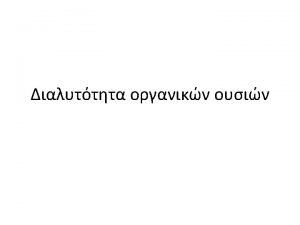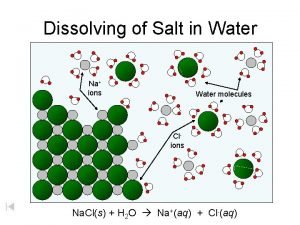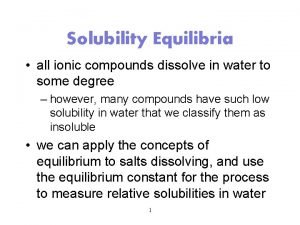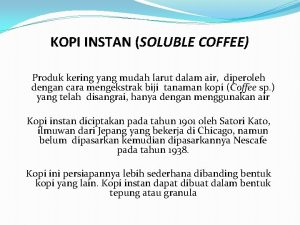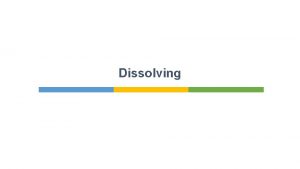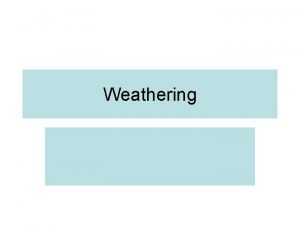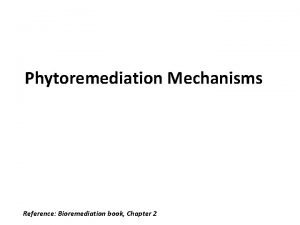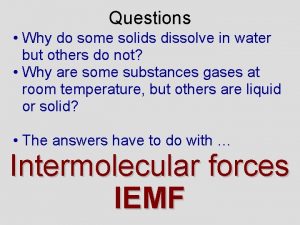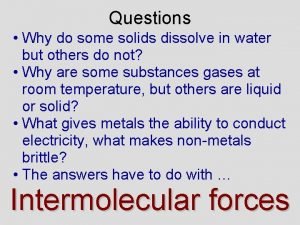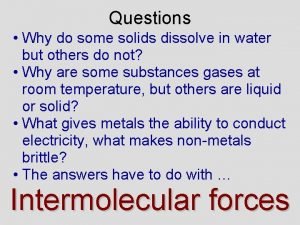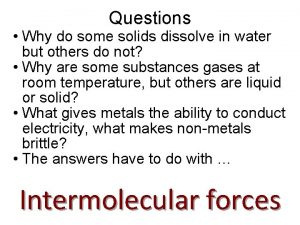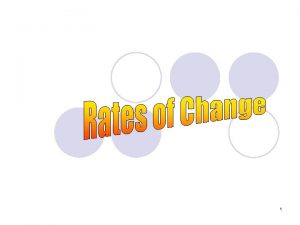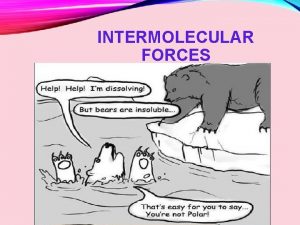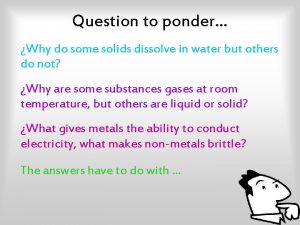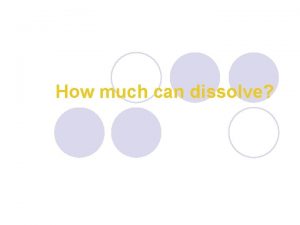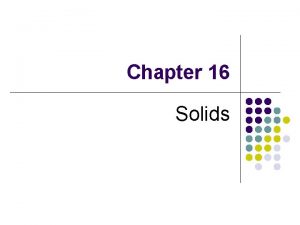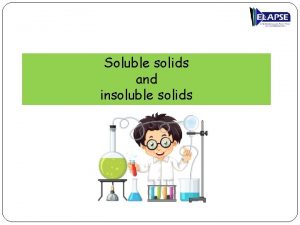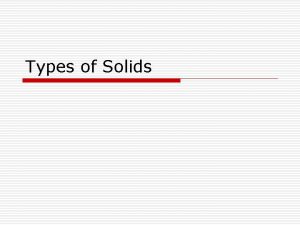Questions Why do some solids dissolve in water













- Slides: 13

Questions • Why do some solids dissolve in water but others do not? • Why are some substances gases at room temperature, but others are liquid or solid? • What gives metals the ability to conduct electricity, what makes non-metals brittle? • The answers have to do with … Intermolecular forces

Intermolecular forces Overview • There are 2 types of attraction in molecules: intramolecular bonds & intermolecular forces • We have already looked at intramolecular bonds (ionic, polar, non-polar) • Intermolecular forces (IMF) have to do with the attraction between molecules (vs. the attraction between atoms in a molecule) • IMFs come in six flavours: 1) ionic, 2) dipole - dipole, 3) H-bonding, 4) London forces, 5) covalent (network solids), 6) metallic

Ionic, Dipole - Dipole attractions • We have seen that molecules + – can have a separation of charge • This happens in both ionic and polar bonds (the greater the EN, the greater the dipoles) H Cl • Molecules are attracted to each other in a compound by these +ve and -ve forces + –

H - bonding • H-bonding is a special type of dipole - dipole attraction that is very strong • It occurs when N, O, or F are bonded to H Q- Calculate the EN for HCl and H 2 O A- HCl = 2. 9 -2. 1 = 0. 8, H 2 O = 3. 5 -2. 1 = 1. 4 • The high EN of NH, OH, and HF bonds cause these to be strong forces (about 5 x stronger than normal dipole-dipole forces) • They are given a special name (H-bonding) because compounds containing these bonds are important in biological systems

London forces • Non-polar molecules do not have dipoles like polar molecules. How, then, can non-polar compounds form solids or liquids? • London forces are named after Fritz London (also called van der Waal forces) • London forces are due to small dipoles that exist in non-polar molecules • Because electrons are moving around in atoms there will be instants when the charge around an atom is not symmetrical • The resulting tiny dipoles cause attractions between atoms/molecules • Read 10. 3 (pg. 351 - 355) and answer …

London forces Instantaneous dipole: Induced dipole: Eventually electrons A dipole forms in one atom are situated so that or molecule, inducing a tiny dipoles form dipole in the other

Testing concepts 1. Which attractions are stronger: intermolecular or intramolecular? 2. How many times stronger is a covalent bond compared to a dipole-dipole attraction? 3. What evidence is there that nonpolar molecules attract each other? 4. Which chemical in table 10. 1 has the weakest intermolecular forces? Which has the strongest? How can you tell? 5. Suggest some ways that the dipoles in London forces are different from the dipoles in dipole-dipole attractions. 6. A) Which would have a lower boiling point: O 2 or F 2? Explain. B) Which would have a lower boiling point: NO or O 2? Explain.

7. Which would you expect to have the higher melting point (or boiling point): C 8 H 18 or C 4 H 10? Explain. 8. What two factors causes hydrogen bonds to be so much stronger than typical dipole-dipole bonds? 9. So far we have discussed 4 kinds of intermolecular forces: ionic, dipole-dipole, hydrogen bonding, and London forces. What kind(s) of intermolecular forces are present in the following substances: a) NH 3, b) SF 6, c) PCl 3, d) Li. Cl, e) HBr, f) CO 2 (hint: consider EN and molecular shape/polarity) Challenge: Ethanol (CH 3 CH 2 OH) and dimethyl ether (CH 3 OCH 3) have the same formula (C 2 H 6 O). Ethanol boils at 78 C, whereas dimethyl ether boils at -24 C. Explain why the boiling point of the ether is so much lower than the boiling point of ethanol. Challenge: try answering the question on the next slide.

Testing concepts 1. Intramolecular are stronger. 2. A covalent bond is 100 x stronger. 3. The molecules gather together as liquids or solids at low temperatures. 4. Based on boiling points, F 2 (-188) has the weakest forces, H 2 S has the strongest (-61). 5. London forces – Are present in all compounds – Can occur between atoms or molecules – Are due to electron movement not to EN – Are transient in nature (dipole-dipole are more permanent). – London forces are weaker

Testing concepts 6. A) F 2 would be lower because it is smaller. Larger atoms/molecules can have their electron clouds more easily deformed and thus have stronger London attractions and higher melting/boiling points. B) O 2 because it has only London forces. NO has a small EN, giving it small dipoles. 7. C 8 H 18 would have the higher melting/boiling point. This is a result of the many more sites available for London forces to form. 8. 1) a large EN, 2) the small sizes of atoms.

Testing concepts 9. a) NH 3: Hydrogen bonding (H + N), London. b) SF 6: London only (it is symmetrical). c) PCl 3: EN=2. 9 -2. 1. Dipole-dipole, London. d) Li. Cl: EN=2. 9 -1. 0. Ionic, (London). e) HBr: EN=2. 8 -2. 1. Dipole-dipole, London. f) CO 2: London only (it is symmetrical) Challenge: In ethanol, H and O are bonded (the large EN results in H-bonding). In dimethyl ether the O is bonded to C (a smaller EN results in a dipole-dipole attraction rather than hydrogen bonding).

H – bonding and boiling point • See pg. 369 – Q – why does BP as period , why are some BP high at period 2?

Testing concepts Boiling points increase down a group (as period increases) for two reasons: 1) EN tends to increase and 2) size increases. A larger size means greater London forces. Boiling points are very high for H 2 O, HF, and NH 3 because these are hydrogen bonds (high EN), creating large intermolecular forces For more lessons, visit www. chalkbored. com
 Water and water and water water
Water and water and water water How to dissolve glycine in water
How to dissolve glycine in water Na+ cl- formula
Na+ cl- formula Mongo seeds can be separated by filtration yes or no
Mongo seeds can be separated by filtration yes or no Volume of a golf ball
Volume of a golf ball Solubility vs solubility product
Solubility vs solubility product Coffee granules dissolve in water
Coffee granules dissolve in water Particle diagram of sugar dissolving in tea
Particle diagram of sugar dissolving in tea Hey hey bye bye
Hey hey bye bye The monophasic liquid dosage form is dash solution
The monophasic liquid dosage form is dash solution Fme dissolve
Fme dissolve Partnership advantages
Partnership advantages Cleopatra's needle weathering
Cleopatra's needle weathering Phytosequestration
Phytosequestration

